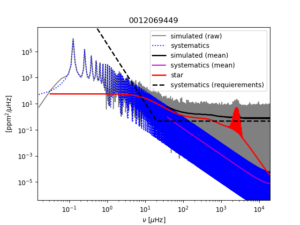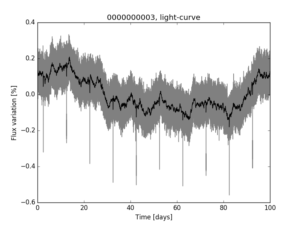PSLS in a nutshell
PSLS simulates solar-like oscillators representative of PLATO targets. It includes planetary transits, stochastically-excited oscillations, granulation, spot modulation, as well as instrumental systematic error and random noises representative for PLATO. The program also manages the existence of the time shift between groups of camera. Planetary transits are included following Mandel & Agol (2002) equations and using the Python implementation by Ian Crossfield at UCLA. The flux modulation induced by spots are modelled following Doren’s (1987)’s model.
Systematic errors representative for PLATO were modelled on the basis of simulations made at pixel level with the Plato Image Simulator (PIS, see Samadi et al 2019). They are representative for different photometry extraction methods: PSF fitting method for the P1 sample and mask-based photometry for the P5 sample (see Marchiori et al 2019). For the latter sample, impact of the mask updates during the quarter are also included. However, it is possible to consider systematic errors without mask updates operating. The random noises are generated by taking into account the shape of aperture mask as well as their updates. For more details see the release notes associated with the version 1.2.
Two different types of oscillation spectrum can be simulated depending of the type of star:
- Main-sequence and sub-giant stars: oscillation spectra based on a set of theoretical frequencies computed with the ADIPLS pulsation code;
- Red-giant stars: oscillation spectra are based on the Universal Pattern (Mosser et al 2011) together with the mixed modes patterns derived from the asymptotic theory (see e.g. Mosser et al 2012).
Rotational mode splitting are implemented in a simplified manner.
The relative flux variation (in ppm) is calculated for a given camera on the basis of the following formula:
INDIVIDUAL_LC = ( ( 1 + ( O + G + A ) * s ) * ( 1 + (RSE + R)*s ) * S * T – 1)/s
where:
- O: oscillations (ppm)
- G: granulation (ppm)
- A: (stochastic) activity (ppm)
- RSE: residual systematic error (ppm)
- R: random error (ppm)
- S: spot (normalized flux)
- T: transit (normalized flux)
- s = 10^(-6)
Note that by nature, the terms O,G, A and R have zero mean.
Some illustrations are displayed here below.
Note the current limitations of the simulator:
- the parameters of the « stochastic » activity component still need to be specified by the user ;
- Empirical detrending of the light-curves is not yet implemented. The detrending is expected to reduce further the systematic errors ;
- The correction of the effects induced the Brighter Fatter Effect, the Charge Transfer Inefficiency (CTI) and IPRNU is not yet introduced in the modelling of the systematic errors. As for the empirical detrending, the correction of these effects is expected to further reduce the level of the residual systematic errors.
This simulator is not an official product of the Plato Mission Consortium (PMC). If you want to simulate the representative PLATO data at pixel level, please consider PLATOSim (http://ivs-kuleuven.github.io/PlatoSim3/)
PSLS is distributed under the terms of the GNU General Public License in the hope that it will be useful, but WITHOUT ANY WARRANTY.
If you use this simulator in your own research, please cite Samadi et al (2019, A&A, 624, A117). Thanks !
(c) 2017 by Réza SAMADI, LIRA – Observatoire de Paris.
Main contributors: Alexis Deru (LIRA), Emmanuel Grolleau (LIRA), Daniel Reese (LIRA), Leigh Smith (University of Cambridge), Cilia Damiani (MPSSR, Gottingen), Lucie Degott (IAS), Jordan Philidet (LIRA).

Power spectrum of a simulated solar-like pulsating dwarf star as it would be observed during 2 years by PLATO.

Simulated light-curve with the presence of a planetary transit